The Smartling Adobe AEM Classic Connector allows you to submit content for translation and automatically download the content to Adobe AEM once translations are complete.
Before you use Adobe to create and manage translation submissions to Smartling, you must install and configure the connector.
Requirements
The Classic Connector is compatible with Adobe AEM Versions 5.6, 6.0 and 6.1.
Java version 1.7 or higher must be installed.
Installation
To make the content available to Adobe AEM:
Upload the connector package
Install and verify the connector
To make sure you have the latest version, download the connector package.
Upload the Smartling Adapter Package
Select Packages from the Adobe AEM home page.

Click Upload Package.
In the Upload Package dialog box, type the file name or click Browse, and select the package. Click OK.
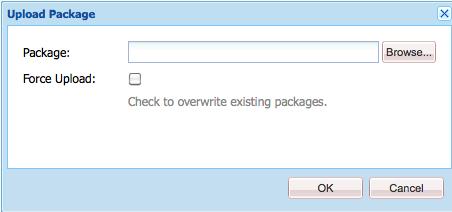
If a package with this name already exists, select Force Upload to overwrite the existing package.
Install the Smartling Package
In the Package Manager browse to the group for the Smartling_adapter package and click Install.

A dialog requests confirmation and lists all of the changes.
Click Install. The Activity Log displays the changes.

When the installation is complete, the package displays with a Last Installed date.
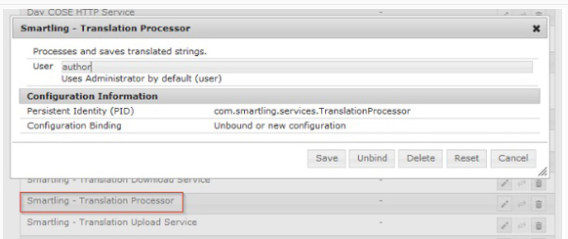
Verifying Installation
After installing the package, open the Web Console Bundles and verify that the Smartling Translation Service is running.
Open OSGi > Bundles in the AEM Web Console. For example, <adobecqdomain>/system/console/bundles.

Search for the word "Smartling" and verify that the service is active.

Open OSGI > Configuration in the Adobe AEM Web Console. For example, <adobecqdomain>/system/console/consfigMgr, verify that "Smartling – Translation Download Service" is defined.

After installing the package, open the Web Console Bundles and verify that the Smartling Translation Service is running.
Open OSGi > Bundles in the AEM Web Console. For example, <adobecqdomain>/system/console/bundles.

Search for the word "Smartling" and verify that the service is active.

Open OSGI > Configuration in the Adobe AEM Web Console. For example, <adobecqdomain>/system/console/consfigMgr, verify that "Smartling – Translation Download Service" is defined.

Uninstalling Packages
Adobe AEM lets you uninstall packages. Uninstalling removes the contents of the package and returns Adobe AEM to the package previously installed.
In the Package Manager, navigate to the group that contains the Smartling_adpater package you wish to uninstall.
Click the package name.
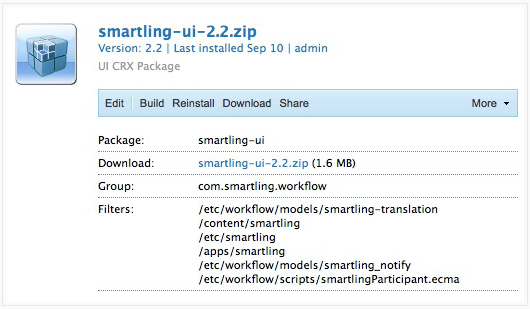
From the More menu, select "Uninstall".
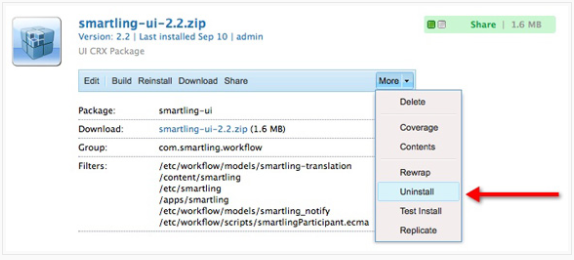
A dialog will request confirmation and list the changes.
Configuration
Adobe stores metadata, scripts, and all other page components as content, therefore you will need to define page properties and parser types to send content for translation.
Configure Adobe AEM Component Property Mapping
Go to the Websites portal > Smartling > Property Mappings.
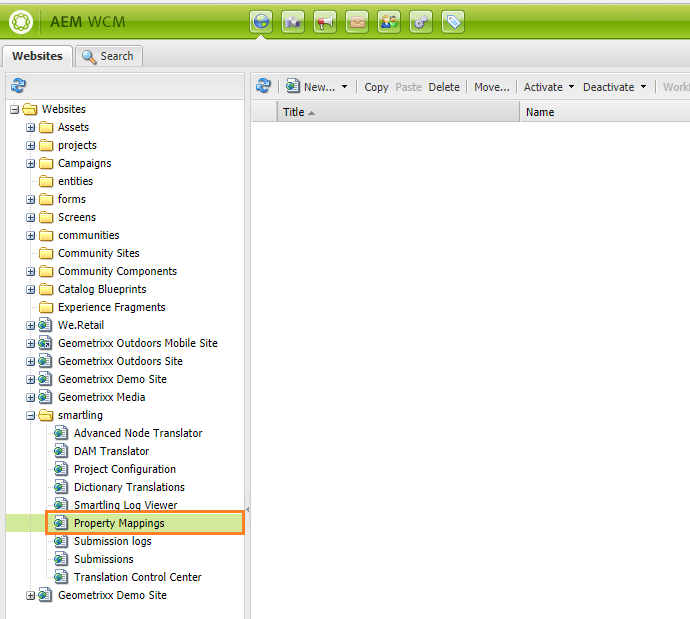
Select Open in Classic UI if the AEM Classic Connector was installed with AEM 6.1+.

Double-click Properties under the first Resource Type entry.
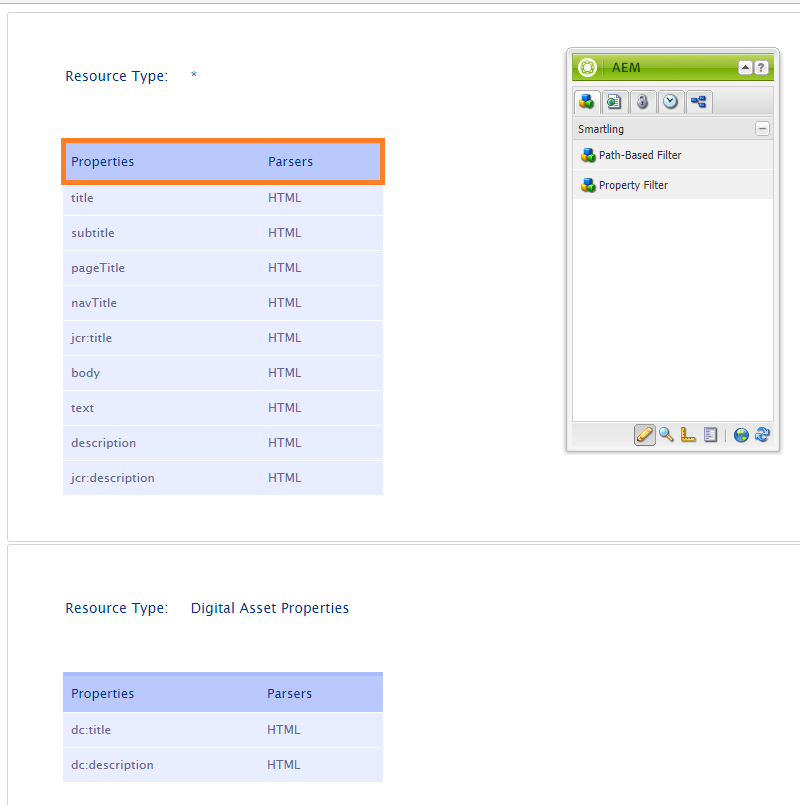
In the Form Field Configurations dialog box, add or delete the Property that you want Adobe to submit to Smartling. It’s possible to select Parser Type for each Property (HTML by default). Then click OK.

One of the default Property Configuration components on this page contains a “” for its Resource Type. DO NOT edit this component instance. The “” tells the system that by default, all Resource Types will automatically include the properties defined in that component.
To create the component for your Custom Resource Type, drag and drop the Property Filter component from the sidekick to the Property Mapping page.

To successfully create the Property Filter component, fill out the Sling Resource Type field with the resource type of content you want to translate. Select Properties are for asset for Digital Asset content. Add Property Parser for each resource property you want to translate: Enter the text field with the property name and select parser type to process it for translation.

The Path-Based Filter component is used to translate content trough "Advanced Node Translator". Drag and drop the Path-Based Filter from the sidekick to the Property Mapping page to create it.

Path field configures the path to translatable content. Property names are an array of node properties which are excluded from translation.

Configuring a Smartling Project for Adobe AEM
Use Smartling to set up a project for each locale you plan to translate with Adobe AEM.
Once you have created a project for each locale, make note of the Smartling API key and Project ID from within the Smartling Dashboard > Settings > API.
Configure the Project IDs and Smartling API Key
Browse to the Websites portal. Under Smartling, double-click Project Configuration.
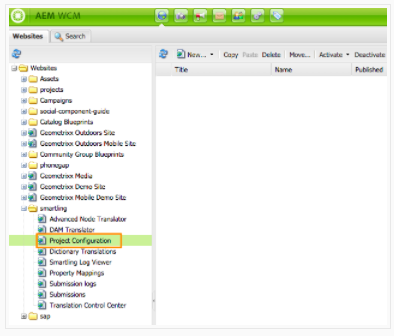
The Smartling Configuration page contains information such as project ID, API key, and language/locale mappings to each of your language sites.

For each of your language sites that you plan to translate, click Add, and complete the required fields. Configurations have different types according the types of site content.
In the General Settings tab, configure: Name, Project ID, User Identifier, User Secret, Callback URL, and Retrieval Type. See our API documentation for help obtaining a User Identifier and User Secret.
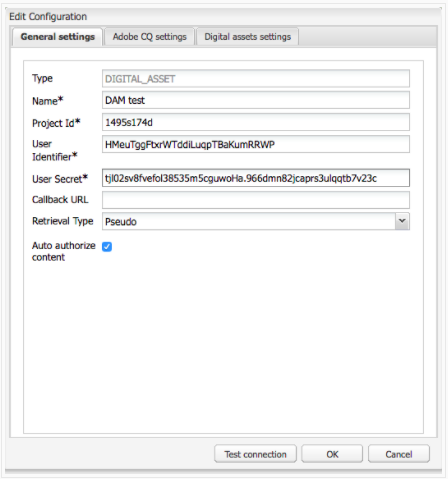
In the Adobe CQ settings tab, configure: Source Path, Source Locale, Target Info (Target Path, Adobe CQ Locale, and Smartling Locale).

For example, to submit pages under /content/geometrixx/en for translation to the fr_fr and de_de site, you need to:
Specify the Source Locale as English.
Under Target Path, create two items:
The first item for the French site is Target Path =/content/geometrixx/fr, Adobe CQ Locale = French (France) and Smartling Locale = fr-FR (optional).
The second item for the German site is Target Path = /content/geometrixx/de, Adobe CQ Locale = German (Germany) and Smartling Locale = de-DE (optional).
To provide context for uploaded content, configure the Content proxy settings tab as follows:
CQ server URL: Domain name of your author server. This must be a 'http://' or 'https://' URL.
login/password: User info with access to browse the page.

Verify your settings by clicking Test Connection.
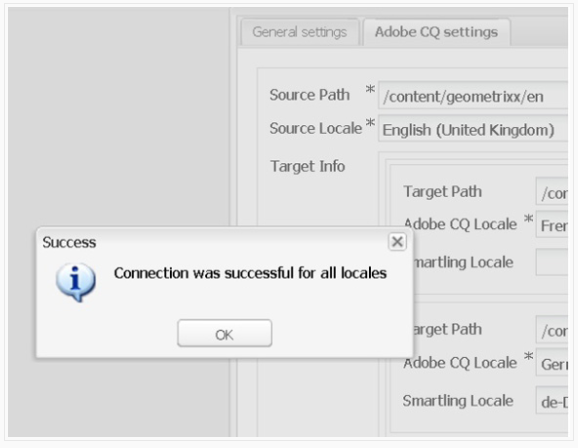
Click OK on the Edit Configuration dialog box. Adobe will add the configuration.
Proxy Configuration
If you are using a proxy with your AEM instance, you may need to do some additional configuration, depending on how your proxy is set up.
Standard Java Proxy
If you start your AEM instance using a standard java https.* proxy, as documented here, Smartling will automatically pick up your proxy settings and work with them. However, we do not support authentication with this method. If you require authentication with a username/password, consider setting up your proxy inside your AEM configuration.
Adobe AEM lets you uninstall packages. Uninstalling removes the contents of the package and returns Adobe AEM to the package previously installed.
In the Package Manager, navigate to the group that contains the Smartling_adpater package you wish to uninstall.
Click the package name.

From the More menu, select "Uninstall".

A dialog will request confirmation and list the changes.
Configuration
Adobe stores metadata, scripts, and all other page components as content, therefore you will need to define page properties and parser types to send content for translation.
Configure Adobe AEM Component Property Mapping
Go to the Websites portal > Smartling > Property Mappings.

Select Open in Classic UI if the AEM Classic Connector was installed with AEM 6.1+.

Double-click Properties under the first Resource Type entry.

In the Form Field Configurations dialog box, add or delete the Property that you want Adobe to submit to Smartling. It’s possible to select Parser Type for each Property (HTML by default). Then click OK.

One of the default Property Configuration components on this page contains a “” for its Resource Type. DO NOT edit this component instance. The “” tells the system that by default, all Resource Types will automatically include the properties defined in that component.
To create the component for your Custom Resource Type, drag and drop the Property Filter component from the sidekick to the Property Mapping page.

To successfully create the Property Filter component, fill out the Sling Resource Type field with the resource type of content you want to translate. Select Properties are for asset for Digital Asset content. Add Property Parser for each resource property you want to translate: Enter the text field with the property name and select parser type to process it for translation.

The Path-Based Filter component is used to translate content trough "Advanced Node Translator". Drag and drop the Path-Based Filter from the sidekick to the Property Mapping page to create it.

Path field configures the path to translatable content. Property names are an array of node properties which are excluded from translation.

Configuring a Smartling Project for Adobe AEM
Use Smartling to set up a project for each locale you plan to translate with Adobe AEM.
Once you have created a project for each locale, make note of the Smartling API key and Project ID from within the Smartling Dashboard > Settings > API.
Configure the Project IDs and Smartling API Key
Browse to the Websites portal. Under Smartling, double-click Project Configuration.

The Smartling Configuration page contains information such as project ID, API key, and language/locale mappings to each of your language sites.

For each of your language sites that you plan to translate, click Add, and complete the required fields. Configurations have different types according the types of site content.
In the General Settings tab, configure: Name, Project ID, User Identifier, User Secret, Callback URL, and Retrieval Type. See our API documentation for help obtaining a User Identifier and User Secret.

In the Adobe CQ settings tab, configure: Source Path, Source Locale, Target Info (Target Path, Adobe CQ Locale, and Smartling Locale).

For example, to submit pages under /content/geometrixx/en for translation to the fr_fr and de_de site, you need to:
Specify the Source Locale as English.
Under Target Path, create two items:
The first item for the French site is Target Path =/content/geometrixx/fr, Adobe CQ Locale = French (France) and Smartling Locale = fr-FR (optional).
The second item for the German site is Target Path = /content/geometrixx/de, Adobe CQ Locale = German (Germany) and Smartling Locale = de-DE (optional).
To provide context for uploaded content, configure the Content proxy settings tab as follows:
CQ server URL: Domain name of your author server. This must be a 'http://' or 'https://' URL.
login/password: User info with access to browse the page.

Verify your settings by clicking Test Connection.

Click OK on the Edit Configuration dialog box. Adobe will add the configuration.
Proxy Configuration
If you are using a proxy with your AEM instance, you may need to do some additional configuration, depending on how your proxy is set up.
Standard Java Proxy
If you start your AEM instance using a standard java https.* proxy, as documented here, Smartling will automatically pick up your proxy settings and work with them. However, we do not support authentication with this method. If you require authentication with a username/password, consider setting up your proxy inside your AEM configuration.
Proxy Configured from AEM
If you have set up your proxy from the AEM Web Console, you can add your proxy details to the Smartling - Network Settings entry in the console. Specify the host and port for the proxy and, if required, authorization credentials.
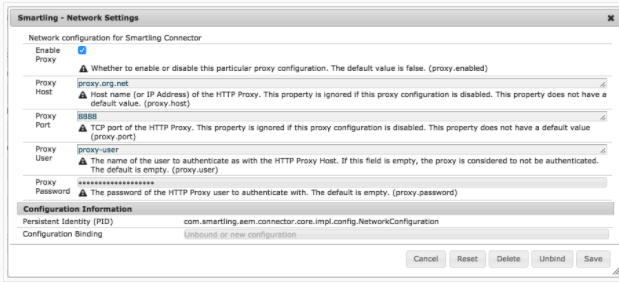
Additional Smartling Configuration
The Smartling Adobe AEM Classic connector provides some additional configuration settings.
Configure Custom Placeholders
By default, the connector captures and masks any placeholders used by the Java MessageFormat, to Translators.
If you want to mask other blocks of your content, you can use a Java Regular Expression to define content that should be captured as a placeholder. Add your Regular Expression in the web console in the Smartling - Translatable Content Configuration component. Depending on your version, this component may be called XML File Generator instead.
Note: It's best to do this as you do your initial setup. If you change this setting once you have started translating, it may change how your strings are captured and cause you to need to redo translations.
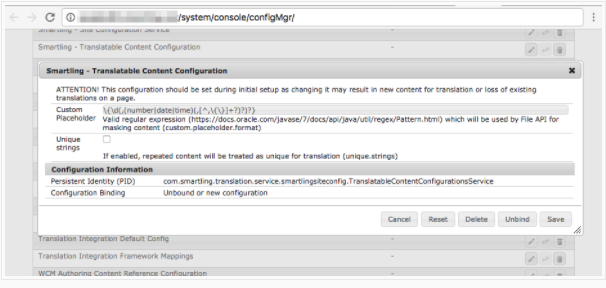
If you have set up your proxy from the AEM Web Console, you can add your proxy details to the Smartling - Network Settings entry in the console. Specify the host and port for the proxy and, if required, authorization credentials.

Additional Smartling Configuration
The Smartling Adobe AEM Classic connector provides some additional configuration settings.
Configure Custom Placeholders
By default, the connector captures and masks any placeholders used by the Java MessageFormat, to Translators.
If you want to mask other blocks of your content, you can use a Java Regular Expression to define content that should be captured as a placeholder. Add your Regular Expression in the web console in the Smartling - Translatable Content Configuration component. Depending on your version, this component may be called XML File Generator instead.
Note: It's best to do this as you do your initial setup. If you change this setting once you have started translating, it may change how your strings are captured and cause you to need to redo translations.

Make Dictionary Strings Unique
By default, Smartling treats strings captured by the connector as being "shared". If you capture the same string twice, only one string will be created in your Smartling project, and the translation applied in both places. In some cases, you may want to apply different translations to the same source string if it appears in different contexts. If you need to do this, check Unique strings in the Smartling - Translatable Content Configuration component.
Take some time when you set up your project to work out if you need unique strings. If you check this box after you have started translating, each string will be created again in your Smartling project and you may lose translations. If this happens, you can use SmartMatch to apply existing translations to your new strings.
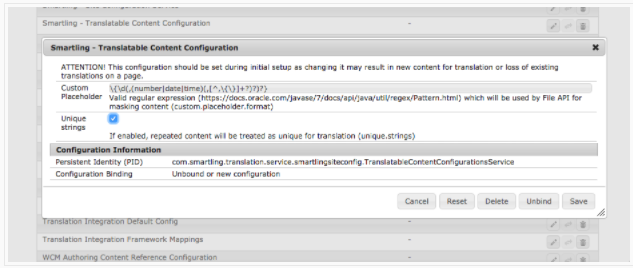
By default, Smartling treats strings captured by the connector as being "shared". If you capture the same string twice, only one string will be created in your Smartling project, and the translation applied in both places. In some cases, you may want to apply different translations to the same source string if it appears in different contexts. If you need to do this, check Unique strings in the Smartling - Translatable Content Configuration component.
Take some time when you set up your project to work out if you need unique strings. If you check this box after you have started translating, each string will be created again in your Smartling project and you may lose translations. If this happens, you can use SmartMatch to apply existing translations to your new strings.

Set Up an Account for Saving Translated Content
You can choose the account that will be used for saving translated content from Smartling. This can help you identify changes made by the Smartling connector.
Open Configuration in the web console (/system/console/configMgr).
Find Smartling - Translation Processor.
Provide account details.

You can choose the account that will be used for saving translated content from Smartling. This can help you identify changes made by the Smartling connector.
Open Configuration in the web console (/system/console/configMgr).
Find Smartling - Translation Processor.
Provide account details.

No comments:
Post a Comment
If you have any doubts or questions, please let us know.